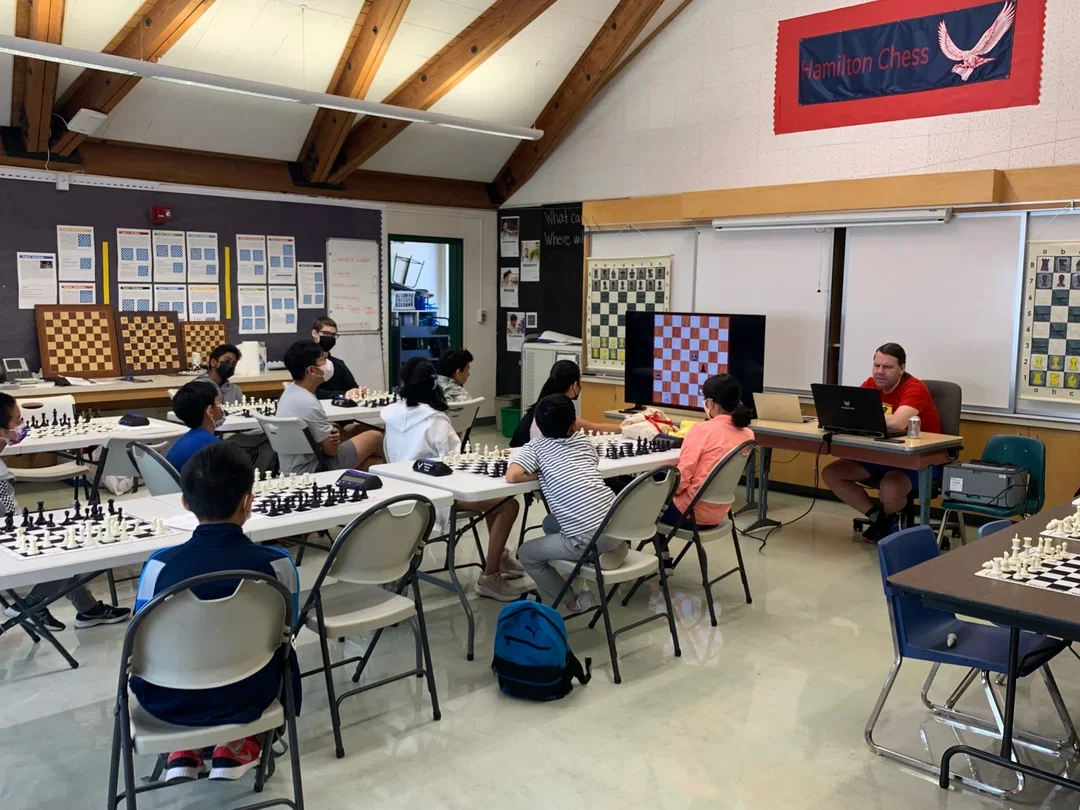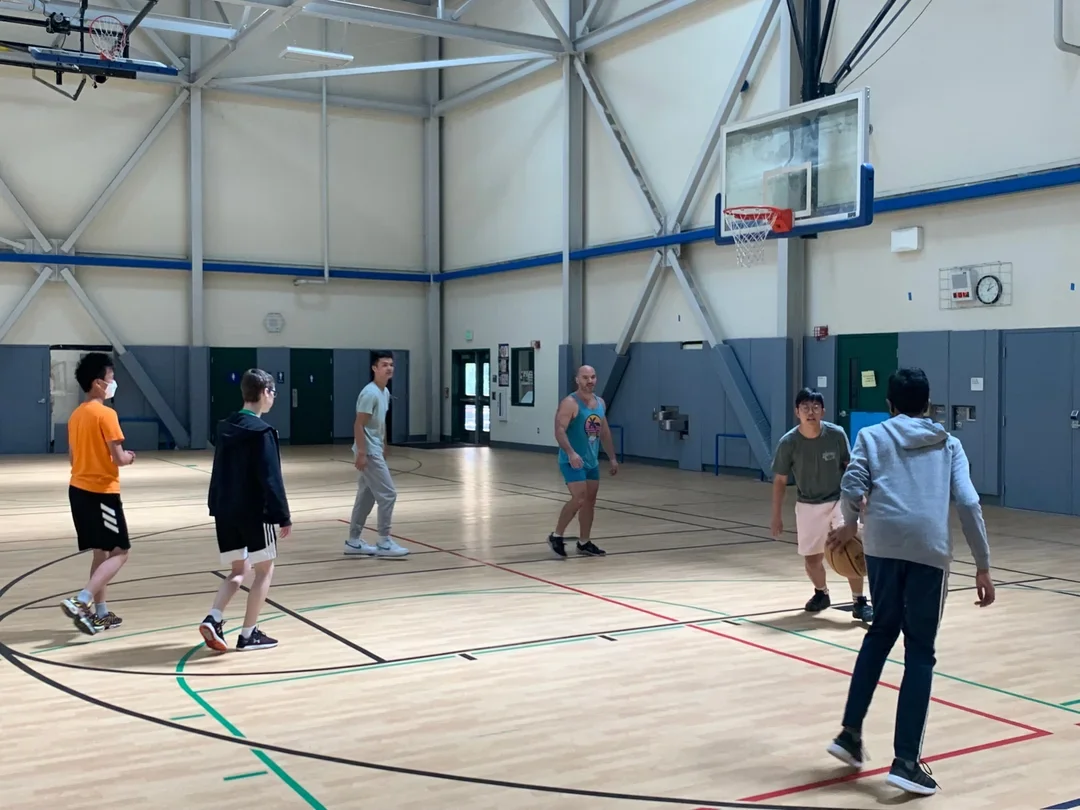After a six-hour flight from New York City to San Francisco, I made it to the 54th U.S. Chess School hosted at the Hamilton Chess Club in Novato, CA. The camp ran from Aug. 9-13 and featured 14 chess prodigies from the ages 10 to 18 years old. Among them was 15-year-old GM Christopher Yoo, who is currently rated 2567 FIDE and started attending the camps when he was 9!

This camp was taught by esteemed author and former British Chess Champion GM Jacob Aagaard. Almost immediately, we dove into the core of the week’s lesson: the three questions to ask when assessing any position.
- What are the weaknesses?
- What is the worst piece?
- What is my opponent’s plan?
There are many ways of approaching chess positions, but Jacob’s approach was all about pattern recognition.
By highlighting certain squares and thinking about how to exploit them, finding chess moves can become surprisingly simple. In the position below, for example:
Building on the three questions was the “Shankland Rule," named by Jacob because that’s how GM Sam Shankland once alluded to it in an online video series. The general premise is to calculate forcing or tempting variations that don’t seem to work and to make them work. Below is an example of the Shankland Rule in action.

During the camp, we spent a lot of time analyzing positions that focused on the bishop. Jacob taught us that a bad bishop can still be better than a good knight if the pawn structure is flexible and allows for a potential center break. In the position below, for instance, white has an f3-e4 pawn break, so even though the bishop on c3 seems blocked by its own d4, b2, and a3 pawns, it will soon become active.
Jacob also discussed bishop-and-pawn vs. rook-and-pawn endings, which are surprisingly tricky to win. Thinking about the three questions, especially assessing the opponent’s idea, is a helpful place to start.
One of my favorite activities from the camp were the training games that we played in teams of three. The time control was G/30 with a five second increment and each team had to play two positions -- one where they were better, and one where they were worse. It was like solving a position, except now we had to solve it for the rest of the game. Although it was stressful with two clocks ticking at the same time and the entire room filled with suspense and chatter, collaborating with other campers was a lot of fun and helped us integrate what we had learned from the camp into our own chess games.
Though we had many long sessions of deep calculation, we honed our physical skills as well. Every day during our break session, some of the campers would play basketball in the indoor gym at Hamilton.

During the camp, we also had a lot of blitz simuls against Jacob! The games were pretty chaotic, and even more so since the time control was G/5 with no increment or delay.


This camp was a great experience for me, and I’m grateful to everyone who helped make it happen. I’d like to thank Dr. Jim Roberts, Chessable, and Chess.com for sponsoring the U.S. Chess School and helping the camps continue to run. I’d also like to thank IM Greg Shahade for organizing the camp, GM Jacob Aagaard for teaching and providing me with the example games and analysis for my annotations, and Abel Talamantez for letting us use the Hamilton facilities for the camp and providing photos for this article.
Categories
Archives
- December 2025 (19)
- November 2025 (29)
- October 2025 (39)
- September 2025 (27)
- August 2025 (29)
- July 2025 (43)
- June 2025 (25)
- May 2025 (24)
- April 2025 (29)
- March 2025 (29)
- February 2025 (20)
- January 2025 (24)
- December 2024 (34)
- November 2024 (18)
- October 2024 (35)
- September 2024 (23)
- August 2024 (27)
- July 2024 (44)
- June 2024 (27)
- May 2024 (31)
- April 2024 (51)
- March 2024 (34)
- February 2024 (25)
- January 2024 (26)
- December 2023 (29)
- November 2023 (26)
- October 2023 (37)
- September 2023 (27)
- August 2023 (37)
- July 2023 (47)
- June 2023 (33)
- May 2023 (37)
- April 2023 (45)
- March 2023 (37)
- February 2023 (28)
- January 2023 (31)
- December 2022 (23)
- November 2022 (32)
- October 2022 (31)
- September 2022 (19)
- August 2022 (39)
- July 2022 (32)
- June 2022 (35)
- May 2022 (21)
- April 2022 (31)
- March 2022 (33)
- February 2022 (21)
- January 2022 (27)
- December 2021 (36)
- November 2021 (34)
- October 2021 (25)
- September 2021 (25)
- August 2021 (41)
- July 2021 (36)
- June 2021 (29)
- May 2021 (29)
- April 2021 (31)
- March 2021 (33)
- February 2021 (28)
- January 2021 (29)
- December 2020 (38)
- November 2020 (40)
- October 2020 (41)
- September 2020 (35)
- August 2020 (38)
- July 2020 (36)
- June 2020 (46)
- May 2020 (42)
- April 2020 (37)
- March 2020 (60)
- February 2020 (38)
- January 2020 (45)
- December 2019 (34)
- November 2019 (35)
- October 2019 (42)
- September 2019 (45)
- August 2019 (56)
- July 2019 (44)
- June 2019 (35)
- May 2019 (40)
- April 2019 (48)
- March 2019 (61)
- February 2019 (39)
- January 2019 (30)
- December 2018 (29)
- November 2018 (51)
- October 2018 (45)
- September 2018 (29)
- August 2018 (49)
- July 2018 (35)
- June 2018 (31)
- May 2018 (39)
- April 2018 (31)
- March 2018 (26)
- February 2018 (33)
- January 2018 (30)
- December 2017 (26)
- November 2017 (24)
- October 2017 (30)
- September 2017 (30)
- August 2017 (31)
- July 2017 (28)
- June 2017 (32)
- May 2017 (26)
- April 2017 (37)
- March 2017 (28)
- February 2017 (30)
- January 2017 (27)
- December 2016 (29)
- November 2016 (24)
- October 2016 (32)
- September 2016 (31)
- August 2016 (27)
- July 2016 (24)
- June 2016 (26)
- May 2016 (19)
- April 2016 (30)
- March 2016 (36)
- February 2016 (28)
- January 2016 (32)
- December 2015 (26)
- November 2015 (23)
- October 2015 (16)
- September 2015 (28)
- August 2015 (28)
- July 2015 (6)
- June 2015 (1)
- May 2015 (2)
- April 2015 (1)
- February 2015 (3)
- January 2015 (1)
- December 2014 (1)
- July 2010 (1)
- October 1991 (1)
- August 1989 (1)
- January 1988 (1)
- December 1983 (1)







